Current events
Next talk on Tuesday in 3 days by Balint Szentpeteri.
News 05.07.2025
New publication: Electric-Field-Tunable Spin−Orbit Gap in a Bilayer Graphene/WSe2 Quantum Dot
Site Content:
24.07.2019
Benedikt Frohn attended the 69th Lindau Nobel Laureate Meeting
Benedikt Frohn attended the 69th Lindau Nobel Laureate Meeting dedicated to physics. The 580 students from 89 countries had the opportunity to discuss among each other and with the 39 Nobel Laureates. During best weather on the beautiful island of Lindau the students consisting of undergraduates, PhD students and post-doctoral researchers had plenty of possibilities to interact with the Nobel Laureates.
Benedikt Frohn says about the meeting: “It was a remarkable experience. The passion for science was ubiquitous and connected students and Laureates. They inspired me to go beyond the boundaries of today’s knowledge. I took a renewed motivation, a broadened scientific horizon and many new friendships home with me.”
Benedikt together with Piotr Kapuściński from CNRS in France and Rebekka Garreis from ETH Zurich in Switzerland won the poster prize at this years "Graphene Study 2019" making it possible to attend the Lindau meeting. In particular, the Graphene Flagship made this possible through a collaboration started this year with the Lindau meeting's organizers. Graphene and 2D materials were also a repeatedly discussed topic with Konstantin Novoselov giving a talk about "Materials of the Future" as well as a Science Breakfast were Graphene Flagship Director Jari Kinaret, Klaus von Klitzing and Novoselov spoke. Here the students had the opportunity to join the discussions and share their ideas about the future materials.
More information can be found at the flagship news-page.
Foto/Credit: Patrick Kunkel/Lindau Nobel Laureate Meetings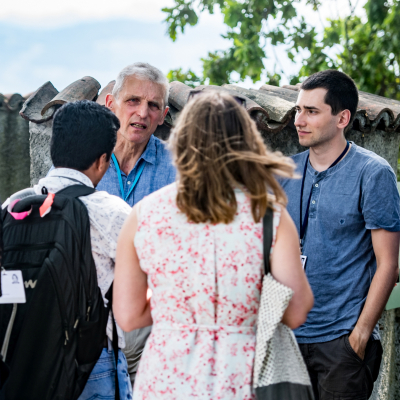

14.06.2019
New Publication: Spin States Protected from Intrinsic Electron-Phonon-Coupling Reaching 100 ns Lifetime at Room Temperature in MoSe2
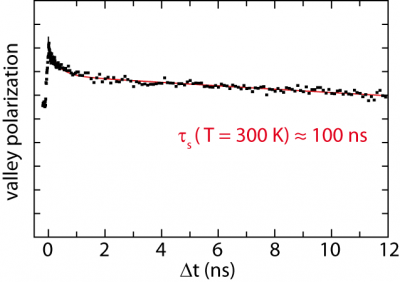
Nano Lett. 19, 4083(2019) We present time-resolved Kerr rotation measurements, showing spin lifetimes of over 100 ns at room temperature in monolayer MoSe2. These long lifetimes are accompanied by an intriguing temperature-dependence of the Kerr amplitude, which increases with temperature up to 50 K and then abruptly switches sign. Using ab initio simulations, we explain the latter behavior in terms of the intrinsic electron–phonon coupling and the activation of transitions to secondary valleys. The phonon-assisted scattering of the photoexcited electron–hole pairs prepares a valley spin polarization within the first few ps after laser excitation. The sign of the total valley magnetization, and thus the Kerr amplitude, switches as a function of temperature, as conduction and valence band states exhibit different phonon-mediated intervalley scattering rates. However, the electron–phonon scattering on the ps time scale does not provide an explanation for the long spin lifetimes. Hence, we deduce that the initial spin polarization must be transferred into spin states, which are protected from the intrinsic electron–phonon coupling, and are most likely resident charge carriers, which are not part of the itinerant valence or conduction band states.

03.06.2019
New Publication: A corner reflector of graphene Dirac fermions as a phonon-scattering sensor
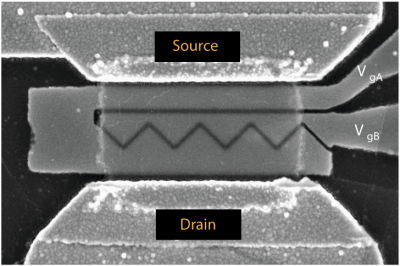
Nat. Commun. 10, 2428 (2019) Dirac fermion optics exploits the refraction of chiral fermions across optics-inspired Klein-tunneling barriers defined by high-transparency p-n junctions. We consider the corner reflector (CR) geometry introduced in optics or radars. We fabricate Dirac fermion CRs using bottom-gate-defined barriers in hBN-encapsulated graphene. By suppressing transmission upon multiple internal reflections, CRs are sensitive to minute phonon scattering rates. Here we report on doping-independent CR transmission in quantitative agreement with a simple scattering model including thermal phonon scattering. As a signature of CRs, we observe Fabry-Pérot oscillations at low temperature, consistent with single-path reflections. Finally, we demonstrate high-frequency operation which promotes CRs as fast phonon detectors. Our work establishes the relevance of Dirac fermion optics in graphene and opens a route for its implementation in topological Dirac matter.

15.05.2019
Supporting SciPost

Christoph Stampfer became an Editorial Fellow at SciPost, joining the Editorial College (Physics).

09.05.2019
Düsseldorf Marathon 28.04.2019
After several months of preparation our Institute was ready to line up at another big sports competition - the Düsseldorf Marathon 2019. Together with over 20000 other runners and the best weather conditions Markus Müller (1:35:59) and Benedikt Frohn (1:42:39) went for the 21.1km half Marathon distance while Michael Schmitz successfully finished the full 42.2km Marathon in 2:59:33. Gratulations!
marathon Düsseldorf_orig.jpeg)

09.05.2019
Powerman Alsdorf 14.04.2019
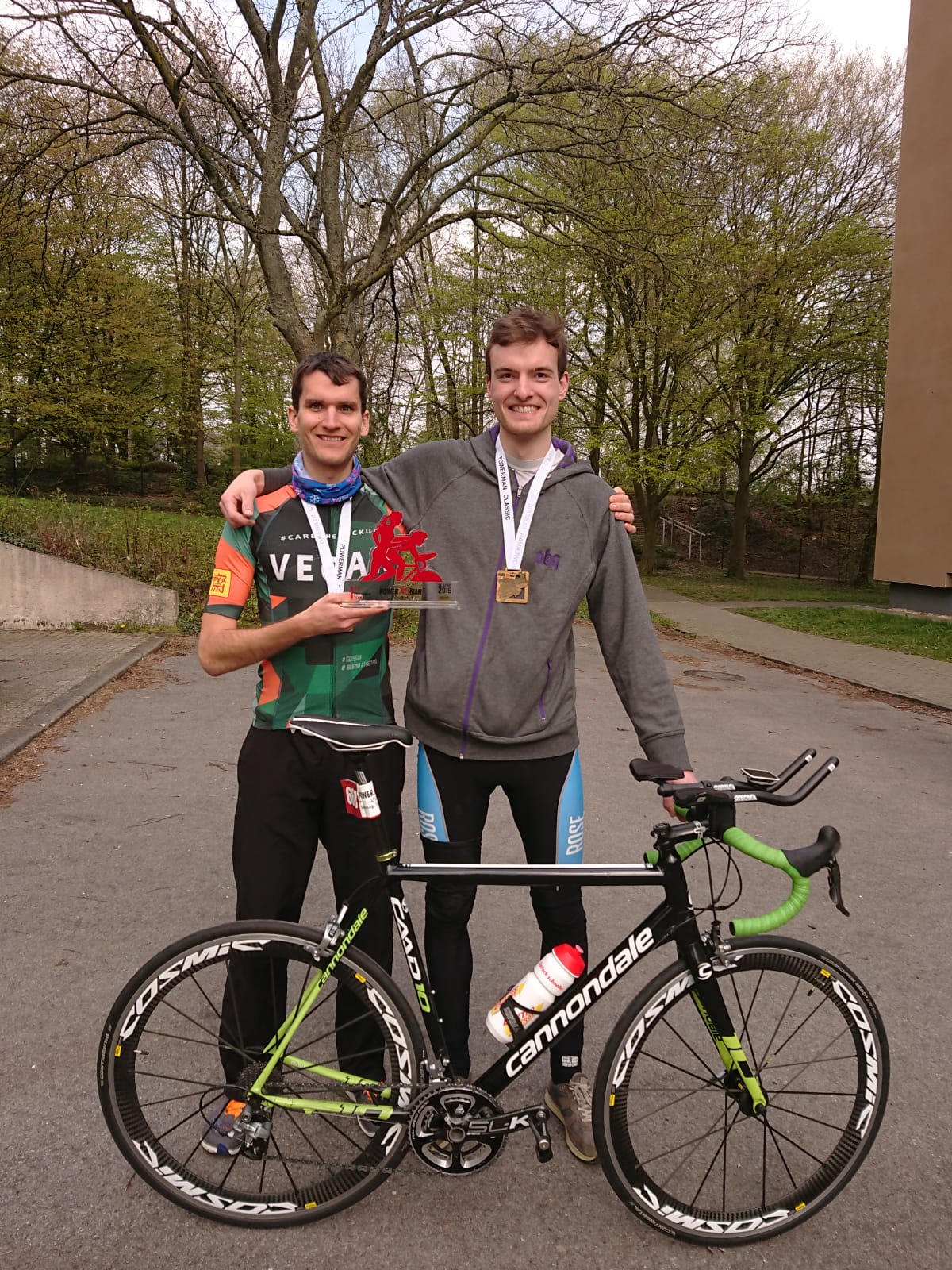
In the early sunday morning the at freezing temperatures and snow fall, our colleagues Michael Schmitz and Samuel Möller took part in the Powerman Alsdorf Duathlon together with over 700 other athletes. Competing in the relay race they had to alternately run, bike and run 10KM/60KM/10KM. With splits of 36:42, 1:34:02 and 37:27 and a total time of 2:50:20 they distanced by far all other relay competitors and took the first place. Gratulations!

23.04.2019
phyphox wins Archimedes award
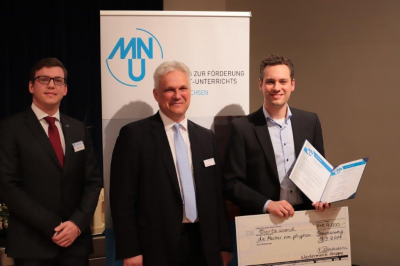
The phyphox team has been awarded the "Archimedes award" 2019 by the "Verband zur Förderung des MINT-Unterrichts" (MNU, loosely translated: association to forward STEM education). The award entails 4,000€ sponsored by the Westermann group. It is awarded yearly, alternating in the fields of mathematics and physics, to decorate innovative concepts and teaching methods as well as particularly commited teachers.
The app allows students to use the sensors of their smartphones to conduct physics experiments in physics education. It has been developed at the 2nd Institute of Physics at the RWTH Aachen University under the direction of Prof. Christoph Stampfer and Dr. Sebastian Staacks statt and it is being continuously refined in cooperation with the 1st Institute of Physics under Prof. Heidrun Heinke and a team of PhD students.
The award does not only mention the app itself, but the MNU emphasizes the value of the accompanying material like the demonstration videos. With more than 600,000 installations worldwide phyphox has been establish in many schools since its first release in September 2016.
phyphox websitePress release by the MNU
Press release by the RWTH Aachen University

04.04.2019
DFG to establish a new Priority Programme on 2D Materials
The German Research Foundation (DFG) is establishing 14 new Priority Programmes (SPP) for the year 2020. This was decided by the DFG Senate in Bonn. One of the 14 new programs, selected from 50 submitted initiatives, was set up with the contribution of Prof. Christoph Stampfer (a member of the Aachen Graphene & 2D Materials Center) and focuses on 2D materials. The new programon is entitled "2D Materials - Physics of van der Waals Heterostructures (2DMP)" and it is coordinated by Prof. Dr. Thomas Heine (TU Dresden).
Press release on the website of the DFG.

